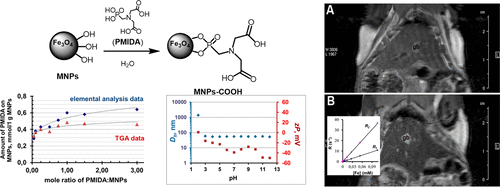Our official English website, www.x-mol.net, welcomes your feedback! (Note: you will need to create a separate account there.)
PMIDA-Modified Fe3O4 Magnetic Nanoparticles: Synthesis and Application for Liver MRI
Langmuir ( IF 3.9 ) Pub Date : 2018-02-24 00:00:00 , DOI: 10.1021/acs.langmuir.7b04023 Alexander M. Demin 1 , Alexandra G. Pershina 2, 3 , Artem S. Minin 4 , Alexander V. Mekhaev 1 , Vladimir V. Ivanov 2 , Sofiya P. Lezhava 2 , Alexandra A. Zakharova 3 , Iliya V. Byzov 4 , Mikhail A. Uimin 4 , Victor P. Krasnov 1 , Ludmila M. Ogorodova 2
Langmuir ( IF 3.9 ) Pub Date : 2018-02-24 00:00:00 , DOI: 10.1021/acs.langmuir.7b04023 Alexander M. Demin 1 , Alexandra G. Pershina 2, 3 , Artem S. Minin 4 , Alexander V. Mekhaev 1 , Vladimir V. Ivanov 2 , Sofiya P. Lezhava 2 , Alexandra A. Zakharova 3 , Iliya V. Byzov 4 , Mikhail A. Uimin 4 , Victor P. Krasnov 1 , Ludmila M. Ogorodova 2
Affiliation

|
The surface modification of Fe3O4-based magnetic nanoparticles (MNPs) with N-(phosphonomethyl)iminodiacetic acid (PMIDA) was studied, and the possibility of their use as magnetic resonance imaging contrast agents was shown. The effect of the added PMIDA amount, the reaction temperature and time on the degree of immobilization of this reagent on MNPs, and the hydrodynamic characteristics of their aqueous colloidal solutions have been systematically investigated for the first time. It has been shown that the optimum condition for the modification of MNPs is the reaction at 40 °C with an equimolar amount of PMIDA for 3.5 h. The modified MNPs were characterized by X-ray diffraction, transmission electron microscopy, Fourier transform infrared spectroscopy, thermogravimetric, and CHN elemental analyses. The dependence of the hydrodynamic characteristics of the MNP colloidal solutions on the concentration and pH of the medium was studied by the dynamic light scattering method. On the basis of the obtained data, we can assume that the PMIDA molecules are fixed on the surface of the MNPs as a monomolecular layer. The modified MNPs had good colloidal stability and high magnetic properties. The calculated relaxivities r2 and r1 were 341 and 102 mmol–1 s–1, respectively. The possibility of using colloidal solutions of PMIDA-modified MNPs as a T2 contrast agent for liver studies in vivo (at a dose of 0.6 mg kg–1) was demonstrated for the first time.
中文翻译:

PMIDA修饰的Fe 3 O 4磁性纳米粒子:肝脏MRI的合成与应用
N对Fe 3 O 4基磁性纳米颗粒(MNPs)的表面改性研究了-(膦酰基甲基)亚氨基二乙酸(PMIDA),并显示了将其用作磁共振成像造影剂的可能性。首次系统地研究了PMIDA的添加量,反应温度和时间对该试剂在MNPs上的固定程度及其胶体水溶液的水动力特性的影响。已经表明,修饰MNP的最佳条件是在40℃下与等摩尔量的PMIDA反应3.5小时。通过X射线衍射,透射电子显微镜,傅立叶变换红外光谱,热重分析和CHN元素分析对修饰的MNP进行表征。通过动态光散射法研究了MNP胶体溶液的水动力特性对介质浓度和pH的依赖性。根据获得的数据,我们可以假定PMIDA分子以单分子层的形式固定在MNP的表面上。修饰的MNP具有良好的胶体稳定性和高磁性能。计算的弛豫率r 2和r 1分别为341和102 mmol –1 s –1。首次证明了将PMIDA修饰的MNPs的胶体溶液作为T 2造影剂用于体内肝脏研究的可能性(剂量为0.6 mg kg –1)。
更新日期:2018-02-24
中文翻译:

PMIDA修饰的Fe 3 O 4磁性纳米粒子:肝脏MRI的合成与应用
N对Fe 3 O 4基磁性纳米颗粒(MNPs)的表面改性研究了-(膦酰基甲基)亚氨基二乙酸(PMIDA),并显示了将其用作磁共振成像造影剂的可能性。首次系统地研究了PMIDA的添加量,反应温度和时间对该试剂在MNPs上的固定程度及其胶体水溶液的水动力特性的影响。已经表明,修饰MNP的最佳条件是在40℃下与等摩尔量的PMIDA反应3.5小时。通过X射线衍射,透射电子显微镜,傅立叶变换红外光谱,热重分析和CHN元素分析对修饰的MNP进行表征。通过动态光散射法研究了MNP胶体溶液的水动力特性对介质浓度和pH的依赖性。根据获得的数据,我们可以假定PMIDA分子以单分子层的形式固定在MNP的表面上。修饰的MNP具有良好的胶体稳定性和高磁性能。计算的弛豫率r 2和r 1分别为341和102 mmol –1 s –1。首次证明了将PMIDA修饰的MNPs的胶体溶液作为T 2造影剂用于体内肝脏研究的可能性(剂量为0.6 mg kg –1)。



























 京公网安备 11010802027423号
京公网安备 11010802027423号